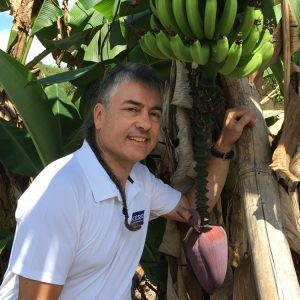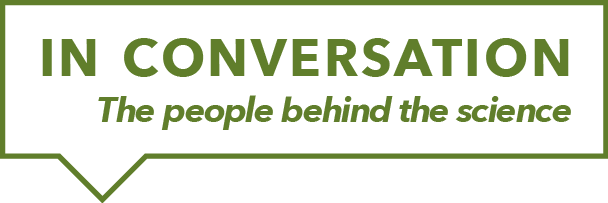
Published on: Nov 26 2019
Meet Michel Aubanel, MSc, Global Flavour Ingredients Manager with Kerry, in conversation with Anne-Marie O’Sullivan from the Kerry Health and Nutrition Institute
Anne-Marie: Tell us about your area of work
Every day at Kerry, I get to work with Mother Nature. Working with the team, my job is to explore potential new raw materials from all over the world. On any one day, that can be Açaí from the Amazon in Brazil for use in carbonated beverages, to Grain of Paradise, a kind of pepper used in West Africa.
Our work involves constantly looking for opportunities to optimise ingredients on yield, on sustainability, and on alternative extraction technologies. We are looking for new ways to improve not just the health of people, but also the planet. For example, this might include whether to use ‘forward’ osmosis to purify water in a more energy-efficient way than ‘reverse’ osmosis. Or looking at new ways to optimise yield in various raw materials such as cocoa beans, flowers and plants, using only water as extraction solvents or looking at how using side-streams more effectively, such as raspberry seeds in Ravifruit.
What I love about my job is that it means I get to meet and work with farmers all around the World –sometimes in exotic places. For example, I visit Kerry’s farmers twice a year in Madagascar, and work with them to improve the quality of the vanilla bean crop.
The program linked to these actions is named “Tsara Kalitao” meaning ‘Good Quality’ in Malagasy. For example, I get to be a part of some initiatives Kerry is working on with people in the remote villages in the Sava region in the north of Madagascar including:
- Working with local agronomists to optimize vanilla bean crop, and income, of local farmers.
- Farmer Income: Advising on vanilla bean crop optimisation – working with two agronomists on the ground
- Supporting budget and finance training for women
I also get to work on an Education Programme. We recognise that support is required for the educational system in the region, to ensure that children attending school can realise their potential. In close cooperation with local officials, teachers and school directors, Kerry has set up an improvement programme together with a local NGO specialising in micro-educational projects. Through this programme, we support and recognise teachers and school management for their increased efforts designed to provide a better standard of education for all children.
What inspired you to choose this career ?
I remember my father coming home with smelling strips in his wedding ring – smelling strips are pieces of paper used to smell a liquid.
He was a perfumer and he often brought me into the forest for walks where we would enjoy the scent of flowers & eat fruit. It was the first step for me in getting “connected” with Mother nature.
Growing up, I was a member of a choir that got to travel all over the world, and I got the opportunity to see and experience new cultures, ways of eating, drinking and perspectives on health.
I was fascinated by what we can do with Mother Nature’s natural raw materials and how to magnify the possibilities using extraction technologies.
So, I started to learn pure chemistry in France and Germany to get the building blocks of understanding before moving on to extraction work.
What projects excite you right now?
Most recently, I have been working with my team on the science of discovering a new tracer to identify whether cooa has been authentically extracted. The tracer is called luteolin, which we described in a scientific paper and presented recently to a congress in Italy in a talk titled “New Component in Cocoa Extract: Luteolin-O- β-D-glucoside.” This work allows me to explore and optimize the benefits of the raw materials we are using.
I also learn a lot and enjoy my role as a member of the IOFI Science Board, as it allows me to learn and exchange with scientists working across the industry and in the world’s most important companies in the area of taste. Our role there is to discuss and better understand how we can address the key challenges facing our industry in the coming years.
Looking at the food and beverage landscape – what is something unique you are working on?
I am really stimulated by new food identified around the Globe such as banana flowers in The Philippines. The banana flowers have a similar aromatic profile as banana fruit, but it’s much more delicate and much less banana-like when still in the blossom form.
When you understand the “why” of such consumption, you can imagine how other raw materials such as flowers, that are not eaten now, could potentially provide a great taste profile.
What research break-throughs excite you at the moment?
Working on water-based extraction is exiting because we are ending up, product by product, with taste profiles that are unique. For instance, a ginger root extracted with water is providing a completely different taste experience than one extracted with ethanol.
Finding ways to blend plants to mimic the taste of endangered plants or botanicals, such as angostura, is another exciting area.
What advice would you give newcomers to your field?
To be curious and really listen, to a farmer in Amazonia growing pineapple, for example, so that you can understand the “why” of the sweet taste of such a fruit.
To learn from your mistakes. Most of the time “mistakes” are a way to open your brain and find an alternative way of working.
To be patient & willing to learn step by step. It takes time in a field like this to really understand the “bigger picture”.
What would you recommend is relevant to learn more about your field, on the Kerry Health and Nutrition Institute?
I was really impressed by the “The Future of Food Preference – What You Should Know from the 13th Pangborn Sensory Science Symposium”
At this conference, The Kerry Health and Nutrition Institute co-organised a workshop entitled ‘Sensory Science as the Bridge between Consumer Behaviour, Nutrition and Health’. This was a great way to explore how sensory research is uniquely positioned at the nexus between food science, nutrition and consumer behaviour to better understand how perception can influence food intake, and be used to moderate the flow of energy and nutrients through our diets.
What are your 3 favourite science books or sources?
I would recommend
Flavour Development:
https://www.amazon.com/Flavor-Development-Various-Industry-Experts/dp/1932633510
Innovation in Food Engineering:
Food Chemistry:


